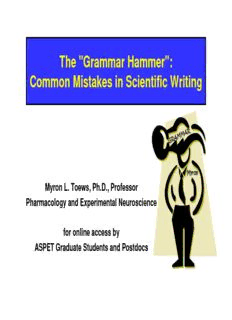
Grammar Hammer PDF
Preview Grammar Hammer
The "Grammar Hammer": Common Mistakes in Scientific Writing Myron Myron L. Toews, Ph.D., Professor Pharmacology and Experimental Neuroscience for online access by ASPET Graduate Students and Postdocs For ASPET visitors: about this slide set None of this slide set matches the order from my presentation at Experimental Biology 2017 I change this material -- content, organization, layouts -- from time to time I hope to have a more user-friendly online version later this year; but I hope this is useful for now Feel free to use this material for your own benefit, but please check with me before passing it on to others (I am a wee bit proprietary about my collection of information) Please feel free to contact me with questions or suggestions for additional content, at [email protected] Grammar Matters! There are rules! Apply to EVERY SECTION of a manuscript and all other scientific writing Good writing can make a bad paper seem better than it is. Bad grammar DOES get in the way of an otherwise good paper. Most people, including very bright scientists and scholars, make many common mistakes. Grammar Matters! Pounded by the Grammar Hammer Cursed commas! Locked up in the Grammar Slammer Quick Review: Parts of Speech Noun: person, place, or thing professor, laboratory, drug, experiment, results Verb: action word or state of being test, determine, explore, run; be, been, am, are, is, was, were Adjective: modifies/describes a NOUN brilliant professor, toxic drug Adverb: modifies/describes a verb or an adjective definitively test, precisely determine, very toxic drug Preposition: in, to, of, on, for, by, at, over, under, into, beside Conjunction: and, or, but Quick Review: Parts of Sentences Subject: who/what does the action Predicate: what the action is Object: what receives the subject's action (object of the verb) The drug cured the patient. The drug caused toxicity. Prepositional phrases The drug cured the patient of his desire to keep smoking. The drug caused toxicity by its actions on D2 dopamine receptors. We use these a lot in scientific writing! Prepositions have their own "objects“ (object of the preposition) of – his desire to – keep smoking by – its actions on – D2 dopamine receptors #1. Don't "space out" with numbers and units. Rule: A number and its units cannot be written as one word Simple and obvious you would not write "10students" as one word! don't write 10ml or 6hr as one word either!! Rule: Use a space if the number and its units are a simple adjective and noun combination Example: The reaction was started by adding 10 μL of substrate. Rule: Use a hyphen if the number and its units are used as an adjective to modify another noun. Example: Cells were grown on a 60-mm dish. Double example: A 12-well plate has 12 wells on each plate. #1. Don't "space out" with numbers and units. Rule: The same rule applies for numbers written as numerals or as words. a 6-well plate a three-step procedure a two-site competition binding curve Note that this includes …. "number plus adjective" (six-sided); and "number plus noun" (four-step) Rule: There are not spaces either before or after the hyphen it is written as if it was one word but word processors will know to break a line at the hyphen Other places for spaces #1. Don't "space out" with numbers and units. Temperatures need spaces, between number and units again between value and degree sign: 37 °C, not 37° C or 37°C Other "places for spaces" around equals sign: n = 3, not n=3 around plus/minus: 29 ± 7, not 29±7 also around >, <, ~, and most other symbols
Description: